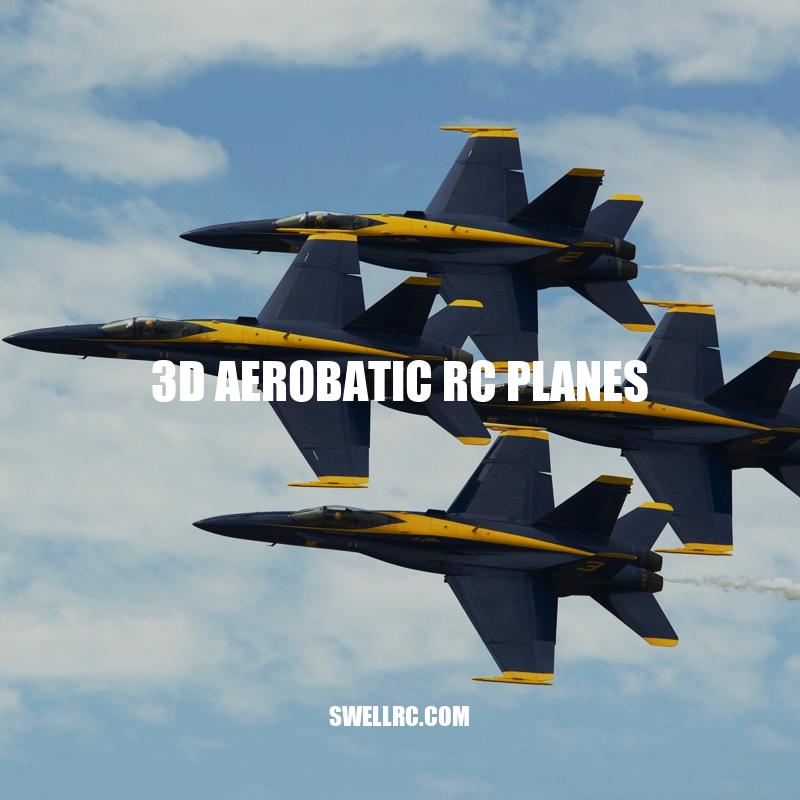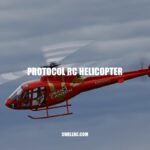Exploring 3D Aerobatic RC Planes: Design, Flying Techniques, and Future
3D Aerobatic RC Planes: Taking RC Flying to the Next Level
RC flying has been a popular hobby for decades, with enthusiasts of all ages creating and flying different types of radio-controlled planes. However, as technology advances, so does the level of excitement and skill in the hobby. Enter 3D aerobatic RC planes – the latest and most thrilling addition to the world of RC flying. These planes are designed to push the limits of flying with their advanced capabilities, allowing pilots to perform stunts and maneuvers that were once impossible. With their customizable features and impressive performance, 3D aerobatic RC planes are quickly gaining popularity among hobbyists worldwide. From basic beginner models to advanced, high-performance planes, there is now a wide range of 3D aerobatic RC planes available for all skill levels. Whether you’re a seasoned pilot or just starting in the hobby, 3D aerobatic RC planes are sure to take your flying to the next level. In this article, we’ll dive into the exciting world of 3D aerobatic RC planes, exploring their unique features, types, techniques for flying, advantages and disadvantages, industry growth, and future.
Features of 3D Aerobatic RC Planes
One of the defining features of 3D aerobatic RC planes is their unique design. These planes are specifically built for maximum maneuverability and agility in the air, with various design elements contributing to their impressive performance. Here are some of the key features of 3D aerobatic RC planes:
- A symmetrical airfoil design, which allows for inverted flight and other advanced maneuvers
- A high-power-to-weight ratio, allowing the plane to accelerate and change direction quickly
- Dihedral wings, which help the plane remain stable in the air
- A lightweight yet sturdy construction, usually made from carbon fiber, balsa wood, or foam
- Large control surfaces, including ailerons, elevators, and rudders, that allow for precise control and maneuverability
In addition to these design elements, 3D aerobatic RC planes also come with various customizable features that allow pilots to tailor their planes to their flying style and preferences. These can include different wing configurations, propellers, motor types, and more. With their advanced features and customizable options, 3D aerobatic RC planes are sure to impress any RC flying enthusiast. For those interested in purchasing their own 3D aerobatic RC plane, websites such as Horizon Hobby and Motion RC offer a wide range of models and accessories to choose from.
What are the different types of RC plane aerobatics?
There are three types of RC plane aerobatics: the Immelmann turn, Split-S, and spin. The Immelmann turn is an ascending half-loop followed by a half-roll, resulting in level flight in the opposite direction at a higher altitude. The Split-S involves a half-roll followed by a descending half-loop. A spin involves a rapid descent while rotating around the plane’s axis. Spin is the most risky maneuver as it requires the most altitude to recover from. The Immelmann turn and Split-S are basic maneuvers that require less airspace.
Types of 3D Aerobatic RC Planes
There are many different types of 3D aerobatic RC planes available on the market, each with their unique features and characteristics. Here are some of the most common types of 3D aerobatic RC planes:
| Type of Plane | Description |
|---|---|
| Biplanes | Biplanes have two sets of wings stacked on top of each other, providing extra lift and maneuverability compared to monoplanes. They also have a more vintage and classic look. |
| Monoplanes | Monoplanes have a single set of wings and are the most common type of 3D aerobatic RC plane. They are known for their speed and agility, making them a favorite among veteran pilots. |
| Electric planes | Electric planes run on rechargeable batteries and are quieter and easier to maintain than gas-powered planes. They are a great option for beginners and those flying in residential areas. |
| Gas-powered planes | Gas-powered planes run on gasoline and have a longer flight time than electric planes. They are typically larger and more powerful, making them a better option for experienced pilots. |
No matter which type of 3D aerobatic RC plane you choose, there are endless possibilities for customization and personalization. In addition to purchasing fully built planes, many websites offer kits that allow you to build your own plane from scratch, adding your own personal touches and modifications along the way. With the variety of options available, it’s no wonder that 3D aerobatic RC planes are becoming more and more popular among RC flying enthusiasts.
What is the advantage of RC plane?
RC planes have several advantages. Firstly, constructing an RC plane from scratch can foster creativity and practical skills. Additionally, they are much cheaper compared to drones. RC planes can also be utilized in weather-reading experiments conducted by government, scientific and military organization. Visit RC plane manufacturer websites like Horizon Hobby (www.horizonhobby.com) and Tower Hobbies (www.towerhobbies.com) for more information.
Techniques for Flying 3D Aerobatic RC Planes
Flying 3D aerobatic RC planes requires precision and skill, but with practice and patience, anyone can learn to perform impressive maneuvers and stunts. Here are some essential techniques for flying 3D aerobatic RC planes:
- Master the basics: Before attempting any complex maneuvers, ensure that you’ve mastered the basics of takeoff, flying straight, turning, and landing.
- Know your plane: Familiarize yourself with the characteristics of your specific plane, including its weight, power, and center of gravity. This will help you understand how it will respond to different movements and forces.
- Practice hovering: Hovering is a core skill for flying 3D aerobatic RC planes and involves keeping the plane stable in one spot in mid-air. Practice hovering in different positions and at different altitudes.
- Learn basic maneuvers: Start with basic maneuvers such as rolls, loops, and inverted flights before moving on to more advanced stunts.
- Perfect stall turns: Stall turns are a signature move for 3D aerobatic RC planes and involve applied rudder control to perform a tight pivot or turn in mid-air.
- Use a simulator: Flying 3D aerobatic RC planes can be costly and time-consuming, so consider using a simulator to train and practice different maneuvers without risking damage to your plane.
These techniques are just the beginning, and as you gain experience and confidence, you can try more advanced maneuvers like knife-edge flights, torque rolls, and more. Many websites offer resources, tutorials, and forums for 3D aerobatic RC pilots, giving you access to a supportive community of fellow enthusiasts and a wealth of knowledge and information. With dedication and practice, anyone can become a skilled 3D aerobatic RC pilot.
What makes an airplane aerobatic?
An airplane is considered aerobatic during flight when the pilot makes sudden changes in the aircraft’s angle, takes an abnormal position, or accelerates abnormally. This type of flight is often associated with aerial acrobatics or shows. For those interested in learning more about aerobatics, aviation schools and organizations such as the International Aerobatic Club offer resources and training programs.
Advantages and Disadvantages of 3D Aerobatic RC Planes
Like any hobby, 3D aerobatic RC planes have their pros and cons. Here are some advantages and disadvantages of owning and flying 3D aerobatic RC planes:
Advantages
- Customizable: 3D aerobatic RC planes offer a high degree of customization and personalization, allowing hobbyists to modify and upgrade their planes to suit their preferences and style.
- Performance: 3D aerobatic RC planes are designed for exceptional speed, agility, and precision, making them ideal for performing impressive stunts and maneuvers in the air.
- Cost-effective: Compared to other hobbies or sports, flying 3D aerobatic RC planes can be relatively cost-effective, with many high-quality planes and accessories available at affordable prices.
Disadvantages
- Skill requirements: Flying 3D aerobatic RC planes requires a significant level of skill and practice, which can be challenging for beginners to master.
- Expensive: While 3D aerobatic RC planes can be cost-effective compared to other hobbies, they can still be quite expensive, especially when factoring in maintenance, repair costs, and upgrades.
- Danger: Flying 3D aerobatic RC planes can be dangerous, with the potential for crashes and injuries, as well as damage to property. It’s important to follow safety guidelines and regulations when flying RC planes.
Despite these challenges, many hobbyists find the rewards of flying 3D aerobatic RC planes to be well worth the investment. There are many websites and online retailers that offer a wide range of planes, accessories, and parts to help hobbyists get started and continue to grow in the hobby. Some popular websites include Horizon Hobby and Motion RC.
What are the advantages of RC planes?
RC planes are mainly used for recreational purposes and by beginners in aero flying. One major advantage of RC planes is that they can improve creativity and practical skills when constructed by oneself at home. Another advantage is that RC planes are much cheaper than drones. Overall, RC planes are a great way to get into the hobby of aviation without breaking the bank. There are various websites and products available to help enthusiasts get started in RC plane flying.
Industry Growth and Future of 3D Aerobatic RC Planes
The industry of 3D aerobatic RC planes has been growing and evolving in recent years, with more and more hobbyists becoming interested in the hobby. Here are some trends in the industry and predictions for the future:
- Advancements in technology: The use of advanced technology in 3D aerobatic RC planes is only going to continue to grow, with more innovative materials and designs being introduced.
- Increased popularity: The overall popularity of RC planes is on the rise, and 3D aerobatic planes are seen as a cutting-edge and exciting aspect of the hobby.
- New products and accessories: As the industry continues to evolve, new products and innovations in accessories and parts are likely to be introduced, allowing hobbyists to further customize and improve their planes.
- More online resources: The growth of the internet has made it easier than ever for hobbyists to connect, share information, and find resources about 3D aerobatic RC planes.
In addition to online resources, there are many websites and communities dedicated to 3D aerobatic RC planes, offering forums, tutorials, and reviews of products. For those looking to enter the hobby, there are also many starter kits, planes, and accessories available for purchase from online retailers. With its exciting maneuvers, precision aerobatics, and customizable features, the future of 3D aerobatic RC planes looks bright.
When did RC planes become popular?
The first official RC contest was in 1937, but it wasn’t until the 1970s that RC planes became massively popular. To see various types of RC aircraft in action, you can watch the film ‘Diamonds in the Sky’ produced by Jay Gerber or visit the website of the Academy of Model Aeronautics, an association of modelers dedicated to the promotion and development of modeling activities.
Conclusion
In summary, 3D aerobatic RC planes offer an exciting and dynamic hobby for those interested in radio-controlled planes and aerobatics. These planes have a unique design that allows for advanced maneuvers and stunts, making them an excellent choice for experienced hobbyists looking for a challenge. Despite the advanced nature of these planes, there are many resources available for those looking to learn and improve their skills, including online communities and tutorials. As technology continues to advance and the industry grows, we can expect to see even more innovation and customization options for 3D aerobatic RC planes. Overall, this is a thrilling and rewarding hobby that can offer hours of entertainment and skill-building for those who are passionate about model aircraft and aviation.



